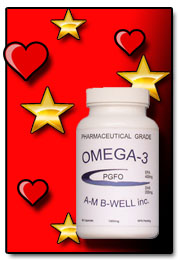


Greetings to all of My Customers, Case Club Members and Friends ...
Hello friends!
February is heart month - and my team thought it best to once again emphasize the importance and benefits of supplementing fish oil into your diet!
The American Heart Association (AHA) recommends a daily intake of 1,000 mg. of Omega-3 for measurable health benefit in cardiovascular care. Daily supplementing with A-M B-Well leads to measurable improvements in Cholesterol levels, Heart Beat irregularity, Blood clots, Circulation and the risk of future Heart attacks.
Please have a look at the article they have picked out going into further detail of the points listed above ...
Sincerely,
Anne-Marie
5 Ways
To Improve Heart Health With Fish Oil
source
: www.fishoilblog.com
What’s the second reason you started taking fish oil, after general health reasons? If you said you wanted to improve your heart health, you’re not alone! In fact, this the number one reason most people get turned on to taking fish oil.
1. Manage Your Cholesterol Levels
If your doctor has told you to start taking fish oil, this is probably why! According to popular science, high cholesterol is one of the leading risks factors for heart disease, yet is one of the easiest things you can control…OK, maybe not ‘easy’, but it can be done!
Chances are, you’ve been given a prescription for a group of drugs called ‘statins’ to help you balance out those cholesterol numbers. These drugs are intended to reduced cholesterol levels. The first thing you should know is that recent studies show that combining fish oil with statins protect heart functions in a way that is more effective than when either used alone!
Fish oil can help you keep both ‘good’ and ‘bad’ types of cholesterol in check, too. Recent studies suggest that the omega-3s found in fish oil raise HDL (that’s the “good” cholesterol) and lower LDL. This is great news!
The second thing you should know is that this is especially if you also have diabetes. People with diabetes tend to have high triglycerides and low HDL levels. Omega-3 fatty acids from fish oil can help lower triglycerides by as much as 25%, reduce apoproteins (markers of diabetes), and increases good cholesterol in diabetics!
2. Decrease Risk Of Irregular Heart Beats
Irregular heart beats or “arrhythmia” are major factors in heart-related deaths, so decreasing this risk is one of the best things you can do to boost heart health.
Fish oil has actually been shown to decrease the risk of these dangerous heart beat irregularities. So much so, that the American Heart Association recommends regular omega-3 consumption to decrease your risk of irregular heart beats, as studies show that low levels of omega-3s are linked to higher rates of arrhythmia.
How does it work? Research suggests that omega-3s work from the inside, out. The fatty acids actually bind to the tissues surrounding the heart and can prevent irregular heart beats during strokes, one of the main causes of sudden cardiac death.
You can only lead a horse to water, though..A key finding published in Circulation, one of the American Heart Association journals, showed that nearly 35% of high risk patients chose not to follow advice given by the experts.
3. Prevent Plaque And Blood Clots
Atherosclerosis is a type of health condition where plaques build up in the arteries. Medical professionals agree plaques are responsible for most heart attacks. When this plaque ruptures, clots can form and prevent blood from passing by.
According to the American Journal of Clinical Nutrition, fish oil can reduce and even prevent heart plaques and blood clots. What’s more, researchers have found there’s an inverse relationship between higher levels of omega-6s and atherosclerosis, too. That means, the higher your omega-6s, the more likely you are to develop these plaques.
Importantly, researchers have also found that C-reactive proteins (CRP) play a very big role in the development of atherosclerosis. Studies published in the American Journal of Cardiology have shown that regular fish oil consumption, and especially the DHA fatty acid found in fish oil, can lower CRP levels.
4. Improve Circulation
People with poor circulation often have thicker blood which contributes to heart problems. Poor circulation is also common in people with diabetes and peripheral arterial disease (PAD).
As a natural anti-coagulant, fish oil is an ideal treatment used to improve circulation. Studies show that fish oil actually works in two ways to benefit circulation: (1) by thinning the blood, a process which involves increasing flexibility in the blood capsules and preventing clotting agents, and (2) by actually widening the walls of the blood vessels themselves.
For these reasons, fish oil is most suitable for improving circulation. However, if you are already taking blood thinning medication it is advisable to check with your doctor and read up on fish oil side effects before adding this supplement to your diet.
5. Reduce The Risk Of Future Heart Attacks
According to the American Heart Association, the strongest evidence of heart-healthy fish oil benefits is for reducing the risk of future heart attacks and preventing cardiovascular disease (CVD) in people who already have it. Similar heart-healthy benefits are seen in people without CVD, too. For example, European researchers discovered omega-3 fish oil protects men from heart failure, a condition that affects around 5 million Americans.
While the reasons for this finding are not entirely understood by researchers, it’s likely a combination of these top 5 fish oil heart benefits. And, whether you starting taking fish oil for your heart or simply to improve your overall health, fish oil can actually help make a healthier you!
Click here to visit the A-M B-Well Inc. order page and get your PGFO today!!!


How too much omega-6 and not enough omega-3 is making us sick
In the last article we discussed the problems humans have converting omega-3 (n-3) fats from plant sources, such as flax seeds and walnuts, to the longer chain derivatives EPA and DHA. Since EPA and DHA (especially DHA) are responsible for the benefits omega-3 fats provide, and since EPA and DHA are only available in significant amounts in seafood, it follows that we should be consuming seafood on a regular basis.
But how much is enough? What does the research literature tell us about the levels of EPA and DHA needed to prevent disease and ensure proper physiological function?
I’m going to answer this question in detail in the next article. But before I do that, I need to make a crucial point: the question of how much omega-3 to eat depends in large part on how much omega-6 we eat.
Over the course of human evolution there has been a dramatic change in the ratio of omega-6 and omega-3 fats consumed in the diet. This change, perhaps more than any other dietary factor, has contributed to the epidemic of modern disease.
The historical ratio of omega-6 to omega-3
Throughout 4-5 million years of hominid evolution, diets were abundant in seafood and other sources of omega-3 long chain fatty acids (EPA & DHA), but relatively low in omega-6 seed oils.
Anthropological research suggests that our hunter-gatherer ancestors consumed omega-6 and omega-3 fats in a ratio of roughly 1:1. It also indicates that both ancient and modern hunter-gatherers were free of the modern inflammatory diseases, like heart disease, cancer, and diabetes, that are the primary causes of death and morbidity today.
At the onset of the industrial revolution (about 140 years ago), there was a marked shift in the ratio of n-6 to n-3 fatty acids in the diet. Consumption of n-6 fats increased at the expense of n-3 fats. This change was due to both the advent of the modern vegetable oil industry and the increased use of cereal grains as feed for domestic livestock (which in turn altered the fatty acid profile of meat that humans consumed).
This chart lists the omega-6 and omega-3 content of various vegetable oils and foods.
Vegetable oil consumption rose dramatically between the beginning and end of the 20th century, and this had an entirely predictable effect on the ratio of omega-6 to omega-3 fats in the American diet. Between 1935 and 1939, the ratio of n-6 to n-3 fatty acids was reported to be 8.4:1. From 1935 to 1985, this ratio increased to 10.3:1 (a 23% increase). Other calculations put the ratio as high as 12.4:1 in 1985. Today, estimates of the ratio range from an average of 10:1 to 20:1, with a ratio as high as 25:1 in some individuals.
In fact, Americans now get almost 20% of their calories from a single food source – soybean oil – with almost 9% of all calories from the omega-6 fat linoleic acid (LA) alone! (PDF)
This reveals that our average intake of n-6 fatty acids is between 10 and 25 times higher than evolutionary norms. The consequences of this dramatic shift cannot be overestimated.
Omega-6 competes with omega-3, and vice versa
As you may recall from the last article, n-6 and n-3 fatty acids compete for the same conversion enzymes. This means that the quantity of n-6 in the diet directly affects the conversion of n-3 ALA, found in plant foods, to long-chain n-3 EPA and DHA, which protect us from disease.
Several studies have shown that the biological availability and activity of n-6 fatty acids are inversely related to the concentration of of n-3 fatty acids in tissue. Studies have also shown that greater composition of EPA & DHA in membranes reduces the availability of AA for eicosanoid production. This is illustrated on the following graph, from a 1992 paper by Dr. William Landis.
The graph shows the predicted concentration of n-6 in the tissue based on dietary intake of n-3. In the U.S. the average person’s tissue concentration of highly unsaturated n-6 fat is 75%. Since we get close to 10% of our calories from n-6, our tissue contains about as much n-6 as it possibly could. This creates a very inflammatory environment and goes a long way towards explaining why 4 in 10 people who die in the U.S. each year die of heart disease. (Note: the ratio of omega-6 to omega-3 matters, but so does the total amount of each.)
In plain english, what this means is that the more omega-3 fat you eat, the less omega-6 will be available to the tissues to produce inflammation. Omega-6 is pro-inflammatory, while omega-3 is neutral. A diet with a lot of omega-6 and not much omega-3 will increase inflammation. A diet of a lot of omega-3 and not much omega-6 will reduce inflammation.
Big Pharma is well aware of the effect of n-6 on inflammation. In fact, the way over-the-counter and prescription NSAIDs (ibuprofen, aspirin, Celebres, etc.) work is by reducing the formation of inflammatory compounds derived from n-6 fatty acids. (The same effect could be achieved by simply limiting dietary intake of n-6, as we will discuss below, but of course the drug companies don’t want you to know that. Less profit for them.)
As we discussed in the previous article, conversion of the short-chain n-3 alpha-linolenic acid (ALA), found in plant foods like flax and walnut, to DHA is extremely poor in most people. Part of the reason for that is that diets high in n-6 LA inhibit conversion of ALA to DHA. For example, one study demonstrated that an increase of LA consumption from 15g/d to 30g/d decreases ALA to DHA conversion by 40%.
Death by vegetable oil
So what are the consequences to human health of an n-6:n-3 ratio that is up to 25 times higher than it should be?
The short answer is that elevated n-6 intakes are associated with an increase in all inflammatory diseases – which is to say virtually all diseases. The list includes (but isn’t limited to):
- cardiovascular disease
- type 2 diabetes
- obesity
- metabolic syndrome
- irritable bowel syndrome & inflammatory bowel disease
- macular degeneration
- rheumatoid arthritis
- asthma
- cancer
- psychiatric disorders
- autoimmune diseases
The relationship between intake n-6 fats and cardiovascular mortality is particularly striking. The following chart, from an article entitled Eicosanoids and Ischemic Heart Disease by Stephan Guyenet, clearly illustrates the correlation between a rising intake of n-6 and increased mortality from heart disease.
As you can see, the USA is right up there at the top with the highest intake of n-6 fat and the greatest risk of death from heart disease.
On the other hand, several clinical studies have shown that decreasing the n-6:n-3 ratio protects against chronic, degenerative diseases. One study showed that replacing corn oil with olive oil and canola oil to reach an n-6:n-3 ratio of 4:1 led to a 70% decrease in total mortality. That is no small difference.
Joseph Hibbeln, a researcher at the National Institute of Health (NIH) who has published several papers on n-3 and n-6 intakes, didn’t mince words when he commented on the rising intake of n-6 in a recent paper:
The increases in world LA consumption over the past century may be considered a very large uncontrolled experiment that may have contributed to increased societal burdens of aggression, depression and cardiovascular mortality.
And those are just the conditions we have the strongest evidence for. It’s likely that the increase in n-6 consumption has played an equally significant role in the rise of nearly every inflammatory disease. Since it is now known that inflammation is involved in nearly all diseases, including obesity and metabolic syndrome, it’s hard to overstate the negative effects of too much omega-6 fat.
In the next article we’ll discuss three different methods for determining healthy intakes of n-3 that take background intake of n-6 into account.
SOURCE:http://chriskresser.com/how-too-much-omega-6-and-not-enough-omega-3-is-making-us-sick
Click here to visit the A-M B-Well Inc. order page and get your PGFO today!!!







5 ml. = 5 capsule
125 ml. / 4 ozs. per bottle
CLICK
HERE
to read label ingredients

90 capsules per bottle
CLICK
HERE
to read label ingredients






A-M B-Well™ Omega-3 PGFO has been third party tested according to the parameters established by the Council for Responsible Nutrition (“CRN”) and the World Health Organization (“WHO”) for its potency and purity by http://www.ifosprogram.com/ and receives a 5 Star rating.
Omega-3 PGFO capsules and Omega-3 Liquid Gold are identical in price, being $25.75 per bottle. Below is a chart listing the prices on the Order Page for Canada and U.S. Retail. The price shows the total price for 1 to 11 bottles with the freight included, then breaks it down by the price per bottle. 8 to 11 bottles are shipped freight-free.
The second chart called Case
Club Membership lists the prices on the Order Page for Canada and U.S.
Wholesale. This chart is to show you how much money you can save per bottle
if you order by the case (12 bottles) and also join the Case Club. You
will further note that the second chart also shows the total price for
bottles for 12, 24 and 36 bottles based on Regular and Case Club prices,
then breaks it down by the price per bottle. As you can see, you are paying
considerably less per bottle by ordering in bulk.







Case Club membership is
$25 per annum.
Club membership gives you a 5% discount on all
your case purchases for one year.
A good idea for customers purchasing 2 or more cases per year.
Visit
our Order Page and choose your Country.
You will be able to choose between Omega-3 PGFO Capsules and Omega-3 Liquid
Gold or order both together.
Warmest Regards,
Anne-Marie

